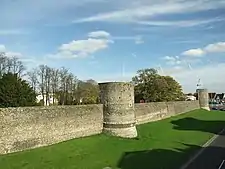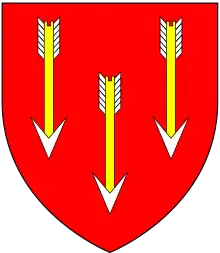John Hales (died 1540)
John Hales (by 1470 – 1540), of The Dungeon in the parish of St. Mary Bredin,[1] Canterbury, Kent, was an administrator, politician and judge[2][3][4] who was appointed a Baron of the Exchequer in 1522.
John Hales | |
|---|---|
 Canterbury city walls, just outside which John Hales' manor of The Dungeon was situated | |
| Born | by 1470 |
| Died | after 20 July 1540 |
| Spouse(s) | Isabel Harry |
| Children | Sir James Hales Thomas Hales Edward Hales William Hales Mildred Hales |
| Parent(s) | John Hales mother's name unknown |

Origins
He was born before 1470,[5] a son of John Hales, of Tenterden in Kent, and a brother of Sir John Hales (died 1555), a Justice of the Common Pleas. His mother's name is not recorded. His grandfather was Henry Hales, of Hales Place at Halden in Tenterden, who married Juliana Capell, a daughter of Richard Capell of Lenden in Tenterden.[6] His great-uncle Thomas Hales was the father of the judge Sir Christopher Hales,[7] Master of the Rolls.
Career
Probably admitted to legal studies at Gray's Inn about 1490, by 1501 he had been appointed steward of the Priory of Christ Church at Canterbury. In 1503 he was made a justice of the peace for Kent, and in 1504 was appointed counsel to the corporation of Rye,[3] and was also elected bailiff of his home town of Tenterden. From 1508, he was appointed to various royal commissions in his native Kent, in Middlesex and Sussex, and across the Channel in the English possessions of Calais and Guînes.[4] By 1509 he had residences at both Canterbury, where he had acquired the manor known as The Dungeon just outside the city walls, and at Nackington.[8]
In 1512 and again in 1515 he was elected a member of parliament for Canterbury, and was also retained as counsel to the corporation of Canterbury. In addition to legal work for the city, he was also employed in drafting legislation for the government.[4] He became a Bencher of Gray's Inn in 1514,[9] giving lectures in that year and in 1520.[4]
His further advancement was probably the result of patronage by Sir Henry Guildford, the Comptroller of the Household,[8] In 1519 he was appointed Attorney-General to the Duchy of Lancaster,[3] in about 1520 steward of St Augustine's Abbey,[4] and in 1521 general surveyor of Crown lands. He retained the last, but gave up the Duchy post when he was appointed third Baron of the Exchequer in 1522.[3] To this was added the responsibility of justice of the peace for Middlesex and Sussex in 1524. As a judge, he was no longer eligible for parliament and in 1523 his seat was taken by his cousin Sir Christopher.[4] After six years in that office, he was appointed second Baron in 1528 but was passed over for Chief Baron the following year.[8][4]
He retired from his judicial position in November 1539 and made his will on 20 July 1540, asking to be buried beside his wife in his parish church of St Mary Bredin at Canterbury. His will bequeathed gold coins to his four surviving sons, his best gold ring to his cousin Sir Christopher, and a gold ring to his daughter Mildred.[3][10][11] He must have died shortly after, but no date survives.[4]
Family
By 1509 he was married to Isabel, daughter and coheiress of Stephen Harry and his wife Isabel, daughter and heiress of William Brooker.[12][13] They had four sons and a daughter:[14]
- James, of The Dungeon.[4]
- Thomas, of Thanington.
- Edward, of Tenterden, who married Margaret, the daughter of John Honywood, of Sene in Hythe,[15] and was the grandfather of Sir Edward Hales, 1st Baronet.[16]
- William, of Nackington.[17]
- Mildred,[4] who married as his first wife John Honywood of Sene in Hythe.[15]
References
- Edward Hasted, 'Canterbury: Manors', in The History and Topographical Survey of the County of Kent: Volume 11 (Canterbury, 1800), pp. 147-164
- Dane John Manor at machadoink.com. Retrieved 6 January 2013.
- Baker, J. H. (3 January 2008), "Hales, John 1469/70–1540?)", Oxford Dictionary of National Biography (subscription or UK public library membership needed), doi:10.1093/ref:odnb/11912
- Miller, Helen (1982), "Hales, John I (by 1480-1540), of Canterbury, Kent", in S.T. Bindoff (ed.), The History of Parliament: the House of Commons 1509-1558, retrieved 8 April 2018
- His age was given as sixty-five in a deposition dated 1 February 1535, suggesting that he was born between 1 February 1469 and 1 February 1470.
- R. Cox Hales states that his grandmother was Juliana Capell.
- Hales 1882, pp. 62–3; Baker 2004
- Baker 2008.
- Baker 2008
- He also left a gold ring to Peter Hayman, who was associated with Hales' son, Thomas, in the service of Thomas Cranmer, Archbishop of Canterbury
- He forgave his son-in-law, John Honywood, all debts owed by him.
- Hasted, Edward (1800), "Canterbury: Manors", The History and Topographical Survey of the County of Kent: Volume 11, Canterbury, pp. 147–164, retrieved 8 April 2018
- Hasted gives her family name as Harvey, but most sources spell it as Harry
- Hales 1882, pp. 62–3; Burke & Burke 1838, pp. 233, 235.
- Honywood 1: Honywood of Charing, Honywood of Honywood, Honywood of Marks Hall, Honywood of Pett, Honywood of Sene, retrieved 4 April 2018
- "HALES, Sir Edward (c.1577-1654), of Woodchurch, Kent and Gray's Inn, London; later of Tunstall, Kent - History of Parliament Online". www.historyofparliamentonline.org.
- R. Cox Hales does not mention this son, but Burke names as fourth son William of Nackington.
- Baker, J.H. (2004). "Hales, Sir Christopher (d. 1541)". Oxford Dictionary of National Biography (online ed.). Oxford University Press. doi:10.1093/ref:odnb/11909. (Subscription or UK public library membership required.)
- Baker, J.H. (2008). "Hales, John (1469/70–1540?)". Oxford Dictionary of National Biography (online ed.). Oxford University Press. doi:10.1093/ref:odnb/11912. (Subscription or UK public library membership required.)
- Burke, John; Burke, John Bernard (1838). A Genealogical and Heraldic History of the Extinct and Dormant Baronetcies of England. London: Scott, Webster and Geary. pp. 233, 235. Retrieved 9 January 2013.CS1 maint: ref=harv (link)
- Foss, Edward (1857). The Judges of England. V. London: Longman Brown. pp. 184–6. Retrieved 20 January 2013.CS1 maint: ref=harv (link)
- Hales, R. Cox (1882). "Brief notes on the Hales Family". Archaeologia Cantiana. XIV. London: Kent Archaeological Society. pp. 61–84. Retrieved 4 January 2013.CS1 maint: ref=harv (link)
| Parliament of England | ||
|---|---|---|
| Preceded by William Crump with Thomas Atwode |
Member of Parliament for Canterbury 1512 and 1515 With: Thomas Wainfleet (1512) with Thomas Atwode (1515) |
Succeeded by Christopher Hales with John Bridges |